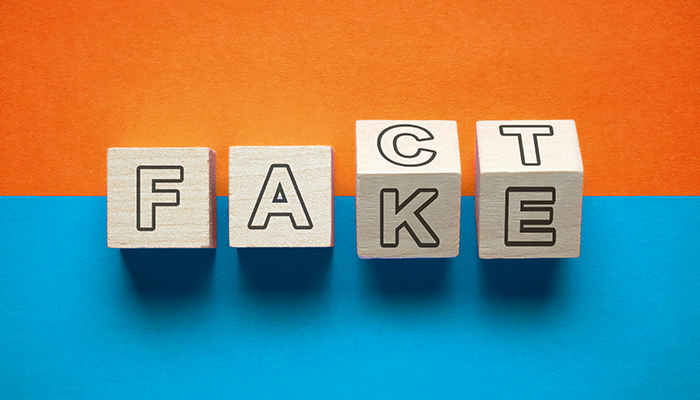‘Both’ Sides Now
When Joe Rogan was accused of spreading misinformation by hosting too many guests touting unproven theories about COVID-19, his solution was simple: He’d add more voices representing the “other side.”
But Rogan, a comedian-turned-UFC color commentator-turned-talk show host, soon came under fire again. The so-called balance he was providing was just making things worse, critics said.
“Bothsidesism”—the practice in the media of presenting both sides of an issue regardless of evidence, facts, or the credibility of sources— grew out of a pressure on news- rooms to avoid showing bias in their reporting. The idea is to be balanced, to be fair. Now researchers and media professionals say that pervasive bothsidesism damages the public’s ability to distinguish evidence-based information.
Professor David Rapp, a psychologist and learning scientist at SESP, sums up the problem with Rogan’s approach: “His solution is to say, ‘OK, we’ll bring in more sources.’ But his audience may not really attend to who those sources are. And anytime you pit two sources against each other, it potentially misrepresents how many people and how much evidence may or may not actually support those sources.”
“When both sides of an argument are presented, people tend to have lower estimates about scientific consensus.” -- David Rapp
Rapp points to COVID-19 news reports about mask- wearing as an example. When an interviewer brings on a pro-mask person and an anti-mask person, it makes it seem like the medical community is split 50-50 on the mask question—and that’s not the case. In other words, giving both sides equal space or time leads audi- ences to believe they are equally credible and equally representative —especially when the interviewer doesn’t challenge their sources or ask for evidence.
A new study coauthored by Rapp and UCLA graduate student Megan Imundo (WCAS18) and published in the Journal of Applied Research in Memory and Cognition found that a false balance in reporting can make people doubt scientific consensus on issues, sometimes making them wonder if an issue is even worth taking seriously.
They performed three experiments to test how people would respond when two positions about climate change were presented as equivalent, even though one side was based on scientific agreement and the other was not.
“When both sides of an argument are presented, people tend to have lower estimates about scientific consensus and seem to be less likely to believe climate change is something to worry about,” Rapp says.
Presenting seemingly equal sides, he says, can prompt one of three problematic results:
- It creates doubt about what people think they know.
- It creates confusion: “I don’t know what’s true, so nothing’s” true.
- It creates reliance: “Someone’s arguing that climate change is not a worry, so that must be a valid idea."
Rapp and Imundo’s research validates concerns that some journalists and newsroom leaders have been raising for years. In her memoir My Life on the Road, activist Gloria Steinem wrote that when she wanted to cover gender issues, an editor worried that “if he published an article saying women were equal, he would have to publish one next to it saying they were not—in order to be objective.”
In 2020, veteran editor Geneva Overholser said journalists aren’t serving the truth “when we’re so devoted to ‘bothsidesism’ that we don’t want to look like we’re favoring anything. It is not a symmetrical situation, yet we act like it is.”
Overholser, a former New York Times editorial board member, Washington Post ombudsperson, and longtime editor of the Des Moines Register, is speaking primarily about traditional newsrooms. But Rapp and other researchers remind us that journalists are hardly the only ones reporting and sharing information now—and that’s part of the challenge.
Consider the Rogan controversy. The Spotify podcaster has millions of listeners and regularly hosts guests who are newsmakers. But that doesn’t necessarily mean Rogan is a journalist—or considers himself beholden to conventional journalistic practices.
“His goal is not necessarily to inform people or help his audience deeply understand scientific ideas or political issues or contemporary debates,” Rapp says. “His goal: ‘I gotta get people to listen.’”
And listen they do—which brings us to our ever-expanding media universe and how nonjournalists earn our trust.
Michael Spikes, a media literacy specialist and learning sciences doctoral student at SESP, points to social media’s steady stream of content—all presented equally in our news feeds—as a source of confusion.
“We have access to so much more information, but we’re less informed than we used to be,” says Spikes, who starts a new role in the fall as lecturer and curriculum specialist at Northwestern’s Medill School of Journalism, Media, Integrated Marketing Communications. “Because our ecosystems are super-open, it allows for so many more bad players to pollute them. We tend to assign credibility based on how easy it is to find the info.”
Rapp’s research into how memory works backs this up and explains why we might be susceptible to misinformation.
“It’s not just that it’s ‘easy’ to get information; it’s that it feels like it’s easy,” he says. “If I have ideas floating around in my head and I can easily retrieve an idea, I believe that idea is truer because I can easily retrieve it.”

So how do we as media consumers, professionals, or educators get out of this cycle?
Rapp and Imundo found one promising strategy that newsroom leaders could use to help readers—even when “both sides” are offered: When participants in their study read a statement emphasizing the broader consensus of experts on climate change, it reduced the weight they gave to climate change deniers.
“If you can remind people about the consensus view, they take that up and they use it,” Rapp says.
Overholser and others have emphasized the need for stronger media literacy pro- grams in our school systems so that the emerging generation can make better sense of the information overload we’re experiencing.
Illinois is one of the first states to require high school students to take a unit of media literacy. Spikes and Yonty Friesem of Columbia College Chicago cofounded the Illinois Media Literacy Coalition, a group helping educators integrate media literacy into all aspects of teaching.
Whether or not these programs can keep up with the growing influence of social media and other platforms will shape our world for decades.
Traditional news organizations— newspapers and news magazines—are struggling to stay relevant and solvent in a fast-changing media environment. Rogan’s podcast remains on Spotify, despite boycotts and protests. Cable news commentary programs proliferate. Tik- Tok and Facebook rule the social media landscape. And few of them seem to fol-low a standard set of rules and ethics as they compete for our attention.
Rogan, for his part, posted a 10-minute Instagram response to growing criticism about misinformation on his podcast, but then made a telling error. He said he loved “Joni Mitchell’s song ‘Chuck E’s in Love.’”
Too bad that song was written and sung by Rickie Lee Jones. Rogan would’ve scored far more points if he’d touted “Both Sides Now,” a song written and sung by Mitchell—and one that captures his new media philosophy.
By Lara Weber
